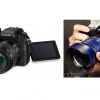As a freelance cameraman, I’ve discovered that straight-to-camera interviews can be really tricky. If your interviewee is not a professional presenter, trying to get them to appear natural and relaxed while talking directly to a small black box of Japanese electrical ingenuity is not easy. If you’re doing a scripted piece, using a teleprompter in front of the camera can help. However, in a lot of cases, you don’t want the interview to come across as scripted; you want it to feel like a natural conversation between the interviewee and the audience. So, what do you do?
I’m sure I’m not the only one that’s tried the old, “I’m going to ask you a question, but I want you to give your answer straight to the camera, not to me” trick. The interviews tend to come across about as natural, warm and human as if you’d asked them to answer in binary. So we often resort to the tried-and-tested, off-camera interview with an interviewer sitting just next to the camera, having a normal, human conversation with them. This tends to be a lot more comfortable for your subject but it does tend to look quite “corporate”, which isn’t always the look we’re going for. If the person is talking about their personal experience or their message is designed for the audience directly, a straight-to-camera approach works an awful lot better.
There are commercially-available products out there to help with this pickle but, for one reason or another, their designs didn’t quite have me convinced. I decided, therefore, to build my own and I’m really pleased with how it’s working. Set-up just consists of slapping it on a tripod and velcro-ing on a couple of light seals, and it functions really nicely. I decided not to cheap-out and use ordinary, one-way mirror glass, instead opting for (horrifically expensive!) teleprompter or “beam-splitter” glass for the semi-transparent mirror. I’m glad that I splashed out; it gives a really clear view of the interviewer from the subject’s perspective and doesn’t show any reflection or distortion from the camera’s point of view.
It also works really nicely as a teleprompter (sometimes known as an Autocue). It uses an iPad Mini which can be remotely controlled from an iPhone to vary the speed, font size, and content of the script. This isn’t going to replace hiring in a dedicated Autocue operator for big-budget shoots- having a professional operator tasked solely with looking after the teleprompter is great if your budget stretches to that luxury- but this little box does work very nicely indeed, and at a fraction of the cost.
So, all in all, I’m pretty happy with it! Check out the video below and let me know what you think. If you’re interested in including this on your next shoot, head over to the CONTACT PAGE and give me a shout.





